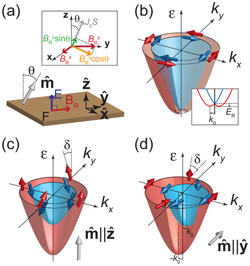Research Abstract
ラシュバスピン軌道結合による磁気異方性とその電場制御
Rashba Spin-Orbit Anisotropy and the Electric Field Control of Magnetism
2014年2月17日 Scientific Reports 4 : 4105 doi: 10.1038/srep04105

電流ではなく電場を用いる極薄強磁性層の磁性の制御には、技術的に重要な潜在用途が数多くある。そのような制御は、電場誘起表面電荷ドーピングによる機構が提案されているが、いまだにいくつかの重要な実験をそうしたシナリオの範囲内で解明できないのが実情である。ラシュバスピン軌道結合は大きな表面電場を反映しており、非磁性金属や半導体の伝導電子のスピン分裂を引き起こす。磁石では、交換磁場によってこのような分裂が変化し、ジャロシンスキー・守谷機構によって大きな磁気異方性エネルギーが生じる。電気的に生じる異方性エネルギーへのこの通常とは異なるが伝統的でもある経路によって、数多くの実験で報告されている電場、厚さ、材料依存性を説明できる。
スチュワート E. バーンズ1,2, 家田 淳一2,3 & 前川 禎通2,3
- マイアミ大学 物理学科(米国)
- 日本原子力研究開発機構 先端基礎研究センター
- 科学技術振興機構 CREST
The control of the magnetism of ultra-thin ferromagnetic layers using an electric field, rather than a current, has many potential technologically important applications. It is usually insisted that such control occurs via an electric field induced surface charge doping that modifies the magnetic anisotropy. However, it remains the case that a number of key experiments cannot be understood within such a scenario. Much studied is the spin-splitting of the conduction electrons of non-magnetic metals or semi-conductors due to the Rashba spin-orbit coupling. This reflects a large surface electric field. For a magnet, this same splitting is modified by the exchange field resulting in a large magnetic anisotropy energy via the Dzyaloshinskii-Moriya mechanism. This different, yet traditional, path to an electrically induced anisotropy energy can explain the electric field, thickness, and material dependence reported in many experiments.

